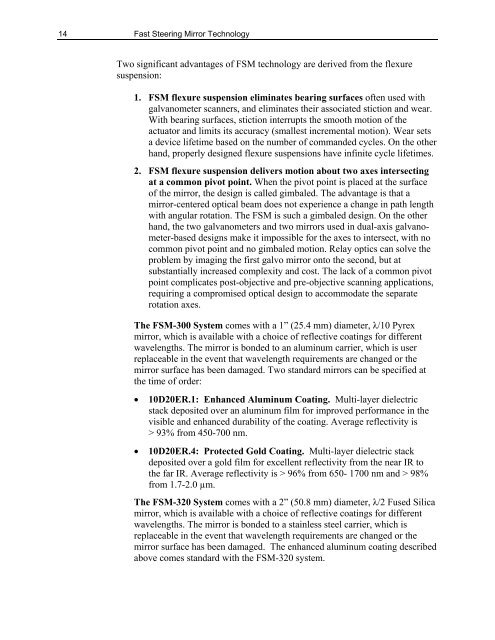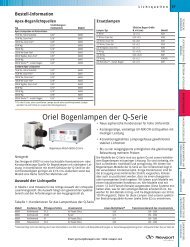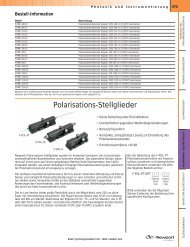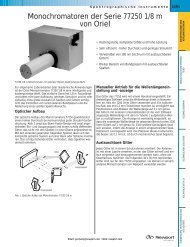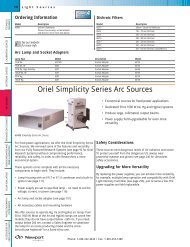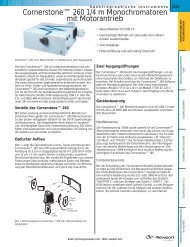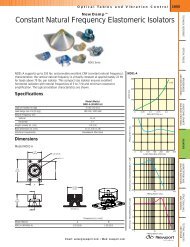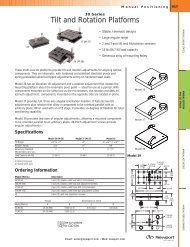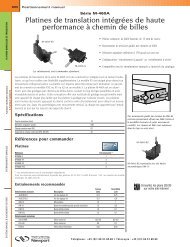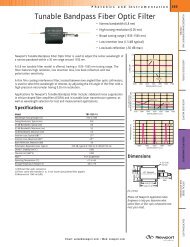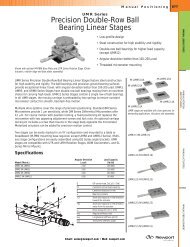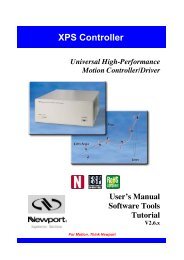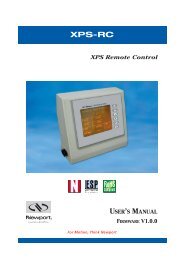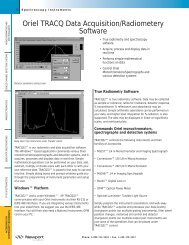FSM-300 or FSM-320 Fast Steering Mirror & FSM-CD300B ...
FSM-300 or FSM-320 Fast Steering Mirror & FSM-CD300B ...
FSM-300 or FSM-320 Fast Steering Mirror & FSM-CD300B ...
Create successful ePaper yourself
Turn your PDF publications into a flip-book with our unique Google optimized e-Paper software.
14 <strong>Fast</strong> <strong>Steering</strong> Mirr<strong>or</strong> Technology<br />
Actuat<strong>or</strong>s<br />
Two significant advantages of <strong>FSM</strong> technology are derived from the flexure<br />
suspension:<br />
1. <strong>FSM</strong> flexure suspension eliminates bearing surfaces often used with<br />
galvanometer scanners, and eliminates their associated stiction and wear.<br />
With bearing surfaces, stiction interrupts the smooth motion of the<br />
actuat<strong>or</strong> and limits its accuracy (smallest incremental motion). Wear sets<br />
a device lifetime based on the number of commanded cycles. On the other<br />
hand, properly designed flexure suspensions have infinite cycle lifetimes.<br />
2. <strong>FSM</strong> flexure suspension delivers motion about two axes intersecting<br />
at a common pivot point. When the pivot point is placed at the surface<br />
of the mirr<strong>or</strong>, the design is called gimbaled. The advantage is that a<br />
mirr<strong>or</strong>-centered optical beam does not experience a change in path length<br />
with angular rotation. The <strong>FSM</strong> is such a gimbaled design. On the other<br />
hand, the two galvanometers and two mirr<strong>or</strong>s used in dual-axis galvanometer-based<br />
designs make it impossible f<strong>or</strong> the axes to intersect, with no<br />
common pivot point and no gimbaled motion. Relay optics can solve the<br />
problem by imaging the first galvo mirr<strong>or</strong> onto the second, but at<br />
substantially increased complexity and cost. The lack of a common pivot<br />
point complicates post-objective and pre-objective scanning applications,<br />
requiring a compromised optical design to accommodate the separate<br />
rotation axes.<br />
The <strong>FSM</strong>-<strong>300</strong> System comes with a 1” (25.4 mm) diameter, λ/10 Pyrex<br />
mirr<strong>or</strong>, which is available with a choice of reflective coatings f<strong>or</strong> different<br />
wavelengths. The mirr<strong>or</strong> is bonded to an aluminum carrier, which is user<br />
replaceable in the event that wavelength requirements are changed <strong>or</strong> the<br />
mirr<strong>or</strong> surface has been damaged. Two standard mirr<strong>or</strong>s can be specified at<br />
the time of <strong>or</strong>der:<br />
• 10D20ER.1: Enhanced Aluminum Coating. Multi-layer dielectric<br />
stack deposited over an aluminum film f<strong>or</strong> improved perf<strong>or</strong>mance in the<br />
visible and enhanced durability of the coating. Average reflectivity is<br />
> 93% from 450-700 nm.<br />
• 10D20ER.4: Protected Gold Coating. Multi-layer dielectric stack<br />
deposited over a gold film f<strong>or</strong> excellent reflectivity from the near IR to<br />
the far IR. Average reflectivity is > 96% from 650- 1700 nm and > 98%<br />
from 1.7-2.0 µm.<br />
The <strong>FSM</strong>-<strong>320</strong> System comes with a 2” (50.8 mm) diameter, λ/2 Fused Silica<br />
mirr<strong>or</strong>, which is available with a choice of reflective coatings f<strong>or</strong> different<br />
wavelengths. The mirr<strong>or</strong> is bonded to a stainless steel carrier, which is<br />
replaceable in the event that wavelength requirements are changed <strong>or</strong> the<br />
mirr<strong>or</strong> surface has been damaged. The enhanced aluminum coating described<br />
above comes standard with the <strong>FSM</strong>-<strong>320</strong> system.


